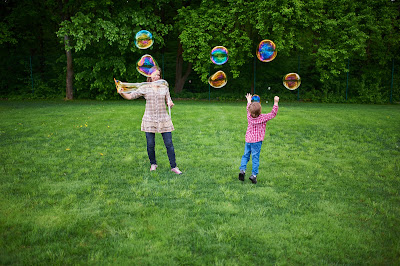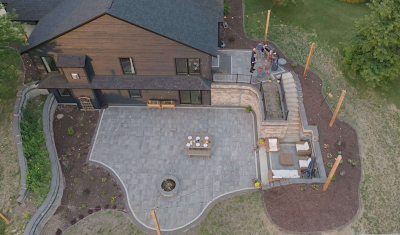Have you ever relished the incredible feeling of post-facial skin? The sensation of cleanliness, freshness, and silky smoothness? Well, aeration works its wonders just like a facial for your yard. By aerating your lawn, you're effectively combating soil compaction, allowing those struggling roots to finally receive the nutrients they crave. It's the secret to fostering long and robust root growth, resulting in a healthier, lusher expanse of vibrant green grass.
Here, Western Landscape uncovers the ins and outs of lawn aeration, guiding you through the signs that indicate your lawn is ready for this remarkable makeover. Get ready to witness the remarkable benefits and gain the knowledge to transform your yard into a picture-perfect oasis of beauty. If you need lawn aeration in Madison, WI, be sure to reach out to us for a seamless job!
What is Lawn Aeration?
Aeration, or aerification is like giving your yard a dose of oxygen, water, and nutrients. It's all about punching small holes in your lawn with professional tools.
Lawn aeration does wonders for your grass. It helps loosen up compacted soil, stops thatch from going overboard, and gives roots the space they need to dive deep and grow like crazy. If you want your grass to stay healthy, lush, and vibrant, regular aeration is the way to go.
Why is Soil Compaction Bad?
Compacted soil is like a stubborn wall that blocks water and nutrients from reaching your plant's roots. The thing is, roots need all the nutrients to grow. When soil gets all compacted, it cramps the style of grass. They end up growing wonky and shallow, which is definitely not their best look. Over time, the grass loses its vibrant color, gets sick, starts thinning out, and will eventually die. Here are a few reasons why soil might get compacted:
●
Construction
●
Heavy foot traffic
●
Pets and children playing
● Extreme weather events
Soil compaction can be very harmful to your lawn and garden if it hasn't had the attention it needs. Soil compaction can cause:
● Rainwater Puddles and Ponding
When soil becomes tightly packed, it creates a barrier that rainwater can't penetrate easily. So instead of gracefully soaking into the ground, the rainwater collects and pools in the lowest areas of your lawn, forming those bothersome puddles that refuse to disappear. This can be especially tough during the spring and fall seasons. It's like your lawn has turned into a water playground, and you're left with the headache of dealing with soggy patches.
● Erosion and Water Runoff
When your soil is tightly packed, stormwater becomes a notorious troublemaker. It effortlessly picks up all sorts of gunk like sediment, fertilizers, herbicides, and pesticides from your lawn. With water unable to drain into the compacted soil, it takes a direct detour into our waterways. Unfortunately, this wreaks havoc on our environment and the delicate balance of aquatic ecosystems. It adds stress to our surroundings and harms the precious creatures that call water their home.
● Lawn Diseases
When nutrients are in short supply and roots are under stress, they become prime targets for these unwelcome ailments. when roots don't have access to the essential nutrients they need, it's like they're left defenseless and weakened.
How to Tell Your Lawn May Need Aeration
●
Your lawn surface becomes
sponge-like and easily dries out.
●
The soil feels hard and compacted
to the touch.
●
Grass begins to thin out or shows
signs of diseases like brown patches.
●
Improper drainage during
rainstorms, resulting in water pooling and forming puddles on the surface.
●
If your lawn was established with
sod over compacted soil without proper mixing, roots struggle to grow into the
underlying ground. Lawn aeration helps break up layering and promotes root
growth by blending the soils.
●
Newly built houses may experience
soil compaction due to construction activities, which can strip away topsoil
and compress the underlying layer.
●
Your lawn experiences heavy foot traffic
or serves as a sports area.
● Regular playtime of kids and pets in the yard can contribute to soil compaction and related issues.
How Lawn Aeration Can Benefit Your Yard
Better Grass Health
Lawn aeration works wonders for your yard by allowing for lush, healthy grass. Aeration improves air circulation, water absorption, and nutrient penetration to the grassroots. This process relieves soil compaction, encourages deeper root growth, and reduces thatch buildup. The result is a revitalized lawn with improved grass health, great color, and increased resilience to environmental stresses.
Minimizes Runoff
Lawn aeration is beneficial because it minimizes runoff. Aeration allows water to penetrate the ground instead of running off the surface by loosening compacted soil. This means better water absorption, reduced erosion, and a healthier, more sustainable yard.
Reduces Fertilizer Needs
Reduced Fertilizer Demands: Grasses in compacted soil often suffer from nitrogen and potassium deficiencies, requiring extra fertilizer. Aeration comes to the rescue by facilitating natural nutrient uptake, enabling grasses to obtain the vital nourishment they require. Let aeration nurture your lawn's nutrient balance.
Increases Beneficial Organisms
Earthworms, soil insects, aerobic bacteria, and fungi thrive in soil that's full of pores and rich in oxygen. When your soil undergoes aeration, these helpful organisms make a comeback, working their magic to maintain soil health and balance. Create a welcoming habitat for these natural allies and watch your soil flourish.
Get Lawn Aeration in Madison, WI!
At Western Landscape, our top priority is the
customer. We take pride in being a landscaping company that provides seamless
work that satisfies our customers. If you think your lawn may benefit from lawn
aeration, give us a call today and we’ll work with you
to develop a maintenance plan. And if you’re unsure, you can always reach out
to us and ask us for advice on the best lawn care services for your yard. We
look forward to hearing from you soon!





